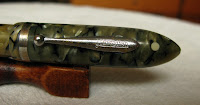Kaweco is a German pen company in business since 1883. As early as in 1908, the model Sport was created—a dip pen of very compact dimensions: 10 cm when capped, and 14 when posted. A 1909 patent allowed the company to create a safety pen that did not leak, and in 1911 a new safety Sport was marketed.
 Pilot pocket pen and Kaweco Sport in aluminum. Posted, the Pilot is 148 mm long, and the Kaweco is 130 mm. Capped, 118 mm for the Pilot; 105 for the Kaweco.
Pilot pocket pen and Kaweco Sport in aluminum. Posted, the Pilot is 148 mm long, and the Kaweco is 130 mm. Capped, 118 mm for the Pilot; 105 for the Kaweco. The year 1934 model was a safety pen made either in artificial horn or in ebonite in a shape very much alike to the current Kaweco Sport. Since then, the Kaweco Sport has preserved that basic style while changing the filling system -- safety, piston, and cartridge-- and the materials –ebonite, celluloid, plastic, aluminum, etc.

This Kaweco Sport model and the typical Japanese pocket pen have some similarities: both are very compact pens when closed, and they have unusually long caps. And posted, they become long enough for a pleasant grip.
Now, the construction of both pens is completely different. Might them be different interpretations of the same idea.












































